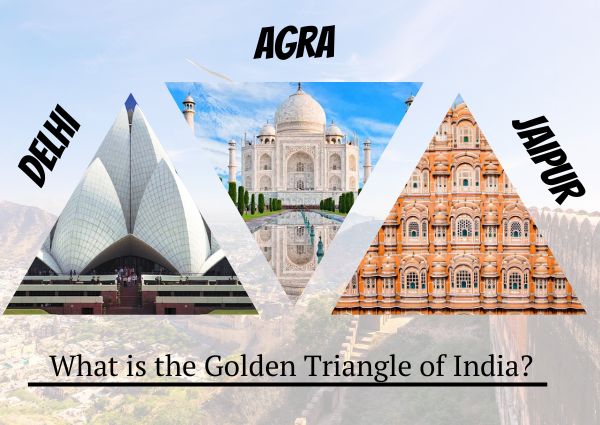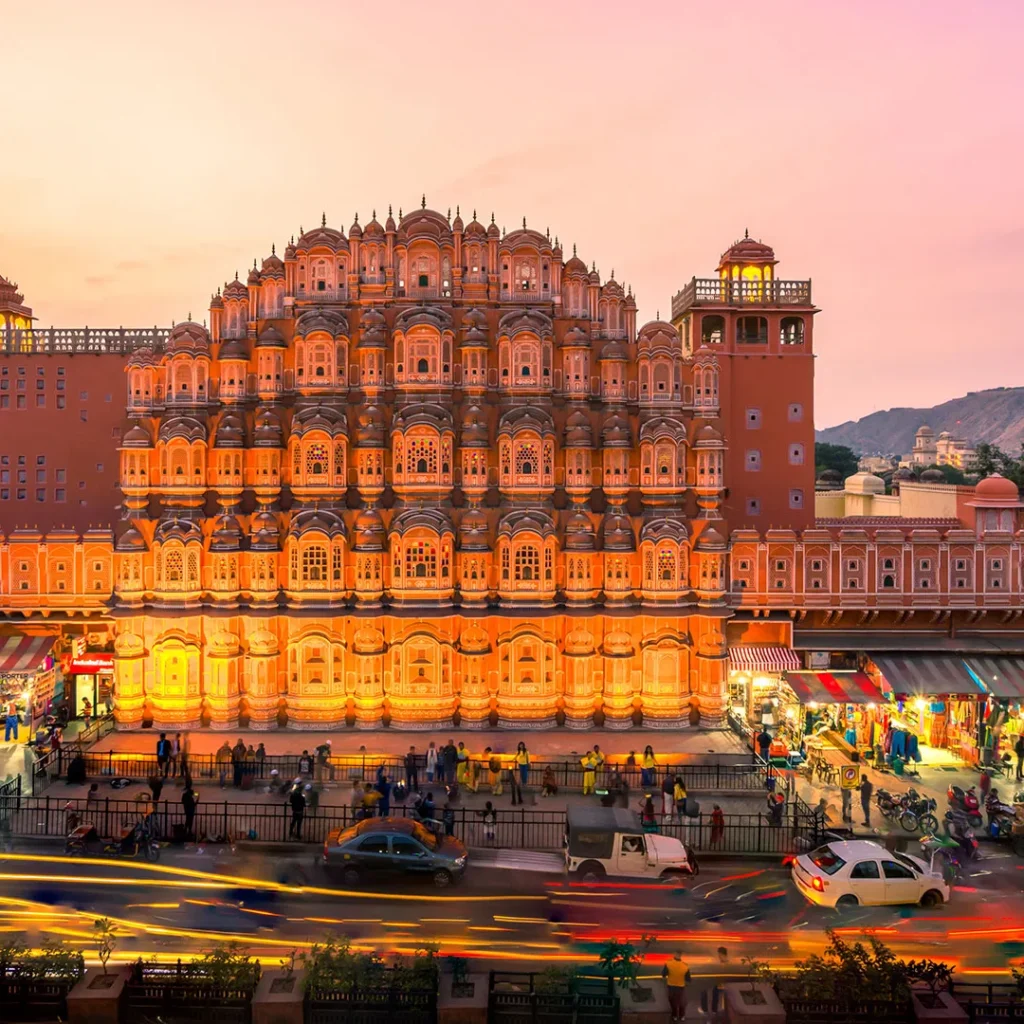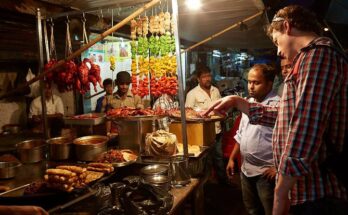Embarking on the Golden Triangle Tour is like stepping into a vibrant kaleidoscope of India’s rich history, diverse cultures, and architectural marvels. This iconic journey takes you through the three most captivating cities of Northern India: Delhi, Agra, and Jaipur. Each destination boasts its unique charm, offering travelers a sensory feast of sights, sounds, and flavors. Let’s delve into the magic of this Golden Triangle, exploring the historical treasures, cultural tapestry, and the timeless allure of these cities.

Delhi: Where the Past Meets the Present
The capital city, Delhi, serves as the starting point of the Golden Triangle Tour. With a history dating back millennia, Delhi seamlessly blends the ancient with the contemporary. Old Delhi, a labyrinth of narrow lanes and bustling markets, is a testament to the city’s Mughal heritage. The iconic Red Fort, a UNESCO World Heritage Site, stands as a formidable reminder of India’s imperial past. As you wander through the bustling Chandni Chowk, the vibrant street life and aromatic street food offer a sensory overload.

On the other hand, New Delhi, the imperial city designed by the British architect Edwin Lutyens, exudes an air of sophistication and modernity. India Gate, an imposing war memorial, and Rashtrapati Bhavan, the President’s official residence, stand as symbols of the city’s grandeur. A visit to Humayun’s Tomb, a masterpiece of Mughal architecture, and Qutub Minar, the world’s tallest brick minaret, transports you to an era of opulence and artistic brilliance.
Agra: The Epitome of Love and Legacy
The next stop on the Golden Triangle is Agra, home to one of the Seven Wonders of the World – the Taj Mahal. This ethereal marble mausoleum, built by Emperor Shah Jahan in memory of his beloved wife Mumtaz Mahal, is an eternal symbol of love. As the first light of dawn bathes the Taj in a soft glow, the monument appears to be cloaked in a magical aura. Exploring the intricate carvings, the sprawling gardens, and the reflective pools that surround the Taj Mahal is an experience that lingers in the heart forever.

Apart from the Taj Mahal, Agra boasts other architectural gems like the Agra Fort and Fatehpur Sikri. The Agra Fort, a UNESCO World Heritage Site, is a majestic red sandstone fortress that narrates the tales of power and passion. Fatehpur Sikri, a deserted city, showcases the grandeur of Mughal architecture with its palaces, mosques, and courtyards.
Jaipur: The Pink City’s Royal Resplendence
The final leg of the Golden Triangle Tour leads to Jaipur, the flamboyant Pink City. Known for its vibrant culture, majestic forts, and palaces, Jaipur is a living testament to the royal legacy of Rajasthan. The City Palace, a magnificent complex of courtyards, gardens, and palaces, offers a glimpse into the opulent lifestyle of the Maharajas. Hawa Mahal, the Palace of Winds, stands as a striking facade with its intricately latticed windows, allowing royal ladies to observe street festivities without being seen.

A visit to the Amer Fort, perched on a hilltop, is a journey back in time. The fort’s impressive architecture, intricate mirror work, and panoramic views of the surrounding hills make it a highlight of Jaipur. Jantar Mantar, an astronomical observatory built by Maharaja Jai Singh II, showcases the scientific prowess of ancient India. The bustling bazaars of Jaipur, filled with colorful textiles, handmade crafts, and traditional jewelry, offer a delightful shopping experience.
Experiencing the Cultural Tapestry
Beyond the architectural splendors, the Golden Triangle Tour allows travelers to immerse themselves in the diverse cultural tapestry of India. Each city has its unique traditions, cuisines, and artistic expressions. In Delhi, savor the street food delights of parathas and chaat, and witness the rhythmic movements of Kathak dancers. Agra, with its Mughlai cuisine, offers a gastronomic journey of kebabs, biryanis, and sweet delicacies like petha. You can book affordable service apartments in Bangalore and other parts of the country using hotel booking app such as Bag2Bag.
Jaipur, surrounded by the arid landscape of Rajasthan, presents a feast of Rajasthani cuisine. Indulge in dal baati churma, laal maas, and ghewar as you soak in the traditional hospitality of the region. The vibrant markets in each city beckon with handcrafted textiles, intricate jewelry, and traditional artifacts, providing an opportunity to take home a piece of India’s rich heritage.
Practical Tips for the Golden Triangle Travelers
Before embarking on the Golden Triangle Tour, consider these practical tips to enhance your travel experience:
- Seasonal Considerations: The best time to visit the Golden Triangle is during the winter months (October to March) when the weather is pleasant. Summers can be scorching, and monsoons bring heavy rainfall.
- Cultural Sensitivity: Respect local customs and traditions. When visiting religious sites, dress modestly, and remove your shoes as a sign of respect.
- Transportation: Hire a knowledgeable guide or use audio guides at historical sites to enhance your understanding of the rich history and cultural significance.
- Local Cuisine Exploration: Don’t miss the opportunity to savor local delicacies. From street food in Delhi to Mughlai cuisine in Agra and Rajasthani flavors in Jaipur, each city offers a unique culinary experience.
- Shopping Adventures: Bargain and explore the bustling markets for authentic souvenirs. Whether it’s textiles, jewelry, or handicrafts, haggling is an accepted part of the shopping experience.
The Golden Triangle Tour weaves together the cultural, historical, and architectural threads of Delhi, Agra, and Jaipur into a mesmerizing tapestry. As you traverse through these cities, each step unveils a new facet of India’s glorious past and vibrant present. The harmonious blend of tradition and modernity, the architectural wonders, and the warm hospitality make the Golden Triangle Tour an unforgettable journey, leaving indelible imprints on the hearts of those who embark on this odyssey.
A Journey Beyond the Golden Triangle
Beyond the realms of the Golden Triangle lies a myriad of possibilities for those seeking to delve deeper into India’s diverse landscapes and cultures. While the tour itself offers a condensed yet comprehensive glimpse into North India’s historical richness, venturing further opens the door to unexplored wonders.
Varanasi: The Spiritual Heartbeat
For travelers with a penchant for spiritual experiences, a detour to Varanasi is highly recommended. Situated on the banks of the sacred Ganges River, Varanasi is one of the oldest continuously inhabited cities in the world. The ghats, or steps leading down to the river, come alive with a symphony of prayer chants, ceremonial rituals, and the mesmerizing spectacle of floating diyas during the evening Ganga Aarti. The city’s narrow lanes hide ancient temples, vibrant markets, and a timeless spiritual aura.
Rishikesh and Haridwar: Yoga by the Ganges
Further north, Rishikesh and Haridwar beckon as the twin jewels on the banks of the Ganges. Known as the Yoga Capital of the World, Rishikesh offers a serene retreat for those seeking spiritual rejuvenation. The iconic Laxman Jhula and Ram Jhula, suspended bridges over the Ganges, provide breathtaking views of the surrounding hills. A short drive away, Haridwar hosts the grand Kumbh Mela, a religious festival that attracts millions of pilgrims.
Udaipur: The City of Lakes
For a contrast to the historical grandeur of the Golden Triangle, Udaipur, the City of Lakes, offers a romantic escape. The picturesque Lake Pichola, surrounded by palaces and temples, sets the stage for a tranquil boat ride. The City Palace, a fusion of Rajasthani and Mughal architecture, showcases ornate courtyards, lush gardens, and panoramic views of the city. Udaipur’s charm lies in its laid-back ambiance, making it a perfect respite from the bustling energy of Delhi, Agra, and Jaipur.
Pushkar: A Melange of Mystique and Color
Known for its annual Camel Fair, Pushkar is a quaint town that captures the essence of rural Rajasthan. The sacred Pushkar Lake, surrounded by ghats and temples, draws pilgrims and photographers alike. The town’s vibrant bazaars offer a kaleidoscope of colors, with traditional Rajasthani textiles, handicrafts, and jewelry adorning the market stalls. Pushkar’s unique blend of spirituality, folklore, and desert landscapes makes it a captivating stop on the journey through Rajasthan.
Amritsar: The Spiritual and Culinary Capital of Punjab
Venturing northwest, Amritsar, in the state of Punjab, beckons with the resplendent Golden Temple. A spiritual and cultural hub for the Sikh community, the Golden Temple is a gleaming sanctuary surrounded by the tranquil waters of the Amrit Sarovar. The daily langar, a community kitchen serving free meals to visitors, epitomizes the Sikh principle of selfless service. Beyond the spiritual realm, Amritsar’s streets come alive with the aromas of Punjabi cuisine, offering a gastronomic journey through hearty dishes like butter chicken, makki di roti, and sarson da saag.
A Glimpse of Wildlife: Ranthambore National Park
For nature enthusiasts, Ranthambore National Park presents an opportunity to witness India’s diverse wildlife. Located near Sawai Madhopur, this tiger reserve is a haven for wildlife photographers and animal lovers. Jeep safaris through the park offer encounters with majestic Bengal tigers, leopards, and a plethora of bird species amidst the scenic backdrop of ancient ruins.
The Golden Triangle Extension: A Tapestry Unraveled
Extending the Golden Triangle Tour to include these enchanting destinations creates a more comprehensive narrative of India’s cultural mosaic. From the spiritual fervor of Varanasi to the serene lakes of Udaipur, the vibrant markets of Pushkar, and the culinary delights of Amritsar, each destination contributes to the rich tapestry of experiences. Whether you’re captivated by history, spirituality, or the kaleidoscope of colors that define India, the Golden Triangle and its extensions promise an odyssey that transcends time and leaves an indelible mark on your travel memories.
Goa: Where Sun, Sand, and Spirituality Converge
Taking a detour towards the west, the coastal paradise of Goa offers a delightful contrast to the historical grandeur experienced in the Golden Triangle. Known for its pristine beaches, vibrant nightlife, and Portuguese-influenced architecture, Goa invites travelers to unwind and embrace a laid-back vibe. From the bustling markets of Anjuna and Mapusa to the historic charm of Old Goa, where colonial churches stand as a testament to the region’s cultural fusion, the state exudes a unique blend of sun-soaked relaxation and cultural exploration.
Mumbai: The City of Dreams
For those with a penchant for the cosmopolitan, a visit to Mumbai, India’s financial capital, is a must. The city pulsates with energy, offering a glimpse into the Bollywood film industry, iconic landmarks like the Gateway of India, and the bustling street life of Colaba. Indulge in the diverse culinary scene, from street food stalls to fine dining restaurants. Mumbai, with its melting pot of cultures and economic dynamism, adds another layer to the cultural kaleidoscope of your Indian journey.
Kerala: Backwaters and Serenity
For a tranquil escape, head south to the enchanting backwaters of Kerala. A network of lagoons, lakes, and canals, the Kerala backwaters provide a serene setting for houseboat cruises. As you drift along the palm-fringed waterways, surrounded by lush greenery, you’ll witness a slower pace of life that contrasts with the hustle and bustle of the Golden Triangle. Explore the spice plantations of Munnar, stroll through the tea gardens, and rejuvenate with Ayurvedic treatments, immersing yourself in Kerala’s natural beauty and holistic traditions.
Hampi: Ruins Amidst Breathtaking Landscapes
For history enthusiasts willing to venture off the beaten path, Hampi, a UNESCO World Heritage Site, awaits in Karnataka. The surreal landscape is dotted with the ruins of the Vijayanagara Empire, showcasing the architectural prowess of a bygone era. The Virupaksha Temple, Lotus Mahal, and the boulder-strewn landscapes create an otherworldly atmosphere. As you explore the ancient temples and majestic ruins against a backdrop of giant boulders, Hampi offers a glimpse into the historical grandeur of South India.
Ladakh: High-altitude Adventure
For the intrepid traveler, a journey to Ladakh, in the northernmost reaches of India, promises a high-altitude adventure. Nestled within the Himalayas, Ladakh’s stark landscapes are punctuated by monasteries perched atop hills, serene lakes, and dramatic mountain passes. The monasteries of Thiksey and Hemis provide a spiritual retreat, while the Nubra Valley and Pangong Lake offer breathtaking vistas. Ladakh’s unique cultural blend of Tibetan Buddhism and Central Asian influences makes it a captivating destination for those seeking both adventure and spiritual introspection.
Embracing Diversity: A Tapestry Complete
The Golden Triangle, when extended to include these diverse destinations, transforms into a grand tapestry that encapsulates the essence of India. From the spiritual fervor of Varanasi to the laid-back beaches of Goa, the bustling streets of Mumbai, the tranquil backwaters of Kerala, the ancient ruins of Hampi, and the high-altitude landscapes of Ladakh, each destination adds a unique thread to the rich fabric of experiences.
Whether you choose to stick to the classical Golden Triangle or extend your journey to these captivating destinations, India invites you to embrace its diversity with open arms. The tapestry of India is woven not just with historical monuments and architectural wonders but also with the warmth of its people, the flavors of its cuisine, and the myriad landscapes that paint a picture of a nation pulsating with life, culture, and endless possibilities. As you traverse this vast and varied land, the memories created will be as diverse as the tapestry itself, leaving an indelible mark on your soul.
1. What is the Golden Triangle Tour in India?
The Golden Triangle Tour is a popular travel circuit that covers three iconic cities in Northern India: Delhi, Agra, and Jaipur. This triangular route is renowned for its historical significance, architectural wonders, and cultural diversity.
2. How long does the Golden Triangle Tour usually take?
The duration of the Golden Triangle Tour typically ranges from 6 to 7 days. This allows travelers to explore the key attractions in each city, savor the local culture, and immerse themselves in the rich history of the region.
3. What are the must-visit attractions in Delhi, Agra, and Jaipur?
In Delhi, visit the Red Fort, India Gate, and Humayun’s Tomb. Agra is renowned for the Taj Mahal, Agra Fort, and Fatehpur Sikri. In Jaipur, explore the City Palace, Hawa Mahal, and the Amer Fort.
4. When is the best time to embark on the Golden Triangle Tour? The ideal time for the Golden Triangle Tour is during the winter months, from October to March, when the weather is pleasant. Summers can be hot, and monsoons bring heavy rainfall, affecting travel plans.
5. Can the Golden Triangle Tour be customized to include other destinations?
Yes, the Golden Triangle Tour can be extended to include additional destinations like Varanasi, Goa, Rishikesh, and more. Customization allows travelers to tailor their itinerary based on personal preferences and interests.
6. What is the significance of Varanasi in the Golden Triangle extension?
Varanasi, situated on the banks of the Ganges River, is a spiritual hub known for its ghats, religious ceremonies, and ancient temples. Adding Varanasi to the itinerary provides a deeper cultural and spiritual experience.
7. How can travelers explore the Golden Triangle responsibly?
To explore the Golden Triangle responsibly, travelers are encouraged to respect local customs, support sustainable tourism practices, and minimize their environmental impact. Hiring local guides and being mindful of cultural sensitivities contribute to responsible travel.
8. What are some recommended activities beyond the Golden Triangle?
Beyond the Golden Triangle, travelers can explore the backwaters of Kerala, the beaches of Goa, the historical ruins of Hampi, and the high-altitude landscapes of Ladakh. These activities offer a diverse range of experiences beyond the classical tour.
9. Are there wildlife experiences near the Golden Triangle?
Ranthambore National Park, near Jaipur, is a popular wildlife destination known for its Bengal tigers. Travelers can embark on safaris to witness diverse flora and fauna in their natural habitat.
10. How can travelers immerse themselves in local cuisine during the Golden Triangle Tour?
To savor local cuisine, travelers are encouraged to try street food in Delhi, indulge in Mughlai delicacies in Agra, and explore Rajasthani flavors in Jaipur. Venturing into local markets and trying regional specialties adds a delightful culinary dimension to the journey.

